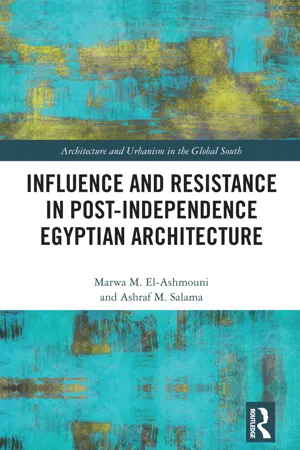
Influence and Resistance in Post-Independence Egyptian Architecture
- 210 pages
- English
- ePUB (mobile friendly)
- Available on iOS & Android
Influence and Resistance in Post-Independence Egyptian Architecture
About This Book
This book is an effort towards an in-depth understanding of the architectural discourse in Egypt developed over more than eight decades. It offers a distinctive theoretical interpretation of the forces shaping the kaleidoscopic shifts in Egyptian architecture through the analysis of the micro space of architectural representation of twentieth century Egyptian architecture. Predicated on historical contextualization, theoretical integration, and global conceptualization, Edward Said's analytical method of contrapuntal reading and the spatial discourse analysis posited by C. Greig Crysler are lucidly assimilated to generate insights into various voices within the architectural discourse in Egypt. The analysis and critique of two important professional magazines, al-'Imarah (1939–1959) and 'Alam al-Bena'a (1980–2000), which shaped the collective psyche of both the academic and professional communities in Egypt and the wider region, coupled with the exploration of two other short-lived magazines, M'imaryah (1982–1989) Medina (1998–2002), and other less-influential professional magazines, discloses the structure of attitude and reference or the exclusions and inclusions that defined the boundaries of the space of the discourse.
Influence and Resistance in Post-Independence Egyptian Architecture paves the way to genuinely debate a yet to mature twenty-first century's architectural discourse in Egypt. This book is a key resource for architects, architectural historians, and critical theorists and will appeal to academics and to both graduate and advanced undergraduate students in architectural history and theory and Middle East and Global South studies.
Frequently asked questions
Information
Table of contents
- Cover
- Half Title
- Series
- Title
- Copyright
- Contents
- List of Figures
- Acknowledgments
- Introduction: Narrating the Architectural Discourse in Egypt
- 1 Influence, Resistance, and the Spaces of Local Discourse
- 2 Global Conceptions and Incentives of Local Departures
- 3 Historical Voice: Reoccurrence of Influence and Resistance
- 4 Western Voice: Intertwined Attitude of Reference
- 5 Configuration of the Local Discourse (1930s–1970s)
- 6 Reconfiguration of Space (1980s–2000s)
- 7 An Outlook into the Twenty-First Century: The Rationale of a Decolonized Discourse
- Bibliography
- Index